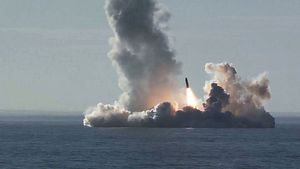The Project 955 Borei-class (“North Wind”) aka Dolgoruky-class nuclear-powered ballistic missile submarine (SSBN) Yuri Dolgoruky test fired four Bulava (RSM-56) intercontinental-range ballistic missiles from a submerged position in the White Sea off the northwest coast of Russia on May 22, the Russian Ministry of Defense (MoD) announced in a statement.
According to the MoD, all four submarine-launched ballistic missiles (SLBMs) successfully struck their designated targets at the Kura Missile Test Range located in northern Kamchatka in the Russian Far East (see video). The four missiles were launched in rapid succession within 20 seconds.
“The missiles were fired from a submerged position, successfully completing the mission,” the MOD said. “The test confirmed [the] combat readiness of the Project-955 Borei SSBN and the Bulava missile system. It was the first-ever salvo fire from this type of submarine. The SSBN crew demonstrated high professional skills in preparing for the test launch and in the process itself.”
Borei-class SSBNs can carry 12 to 16 Bulava (NATO reporting name SS-NX-30 or SS-N-32) SLBMs each armed with six to ten nuclear MIRV warheads yielding 100 to 150 kilotons apiece, as well as 10 to 40 decoys. “4 SLBM can deliver total of 24 MIRV warheads with 2,400 kilotons = 160 Hiroshimas,” Hans Kristensen of the Federation of American Scientists tweeted earlier today. The Bulava is a derivative of the Topol-M SS-27. The three-stage solid propellant (with a liquid head stage) Bulava purportedly has a range of over 8,300 kilometers (5,157 miles). The SLBM constitutes the new backbone of the sea-based component of Russia’s nuclear triad.
The Yuri Dolgoruky last fired a Bulava SLBM from a submerged position in the Barents Sea off the northern coast of Russia in June 2017. The missile reportedly hits its target at the Kura Missile Test Range. Prior to that, the Yuri Dolgoruky launched two Bulava SLBMs from a underwater position in the White Sea in September 2016. The test was only partially a success with one missile successfully striking its target, while the second missile self-destructed shortly after takeoff.
Overall, the Bulava SLBM has officially been test fired 27 times with 15 tests classified as successful, although it is unclear whether some test launches were successful or not. The Russian Navy last test fired four SLBMs (likely R-29R/R-2S) in October 2017.
The Borei-class is the first new class of Russian SSBNs inducted into service with the Russian Navy since the end of the Soviet Union. The new sub class will gradually replace the single remaining Project 941 Typhoon-class boomer as well as Soviet-era Project 667BDR Kal’mar (Squid) Delta-III and Project 667 BDRM Delta IV-class SSBNs.
The Russian Navy currently operates three Borei-class SSBNs. The Yuri Dolgoruky is in service with Russia’s Northern Fleet, while the remaining two – Alexander Nevsky and Vladimir Monomakh — are deployed with the Russian Pacific Fleet. Russia has also been working on an improved Borei-class variant, designated Project 955A Borei II-class, the first of which is expected to be delivered to the Russian Navy in 2019.
The Russian MoD “has plans to build six additional Borei II-class (also designated Borei-A) SSBNs in addition to (…) five already ordered, which eventually will bring up the total number of Borei-class ballistic missile subs to 14,” I explained earlier this week.
































